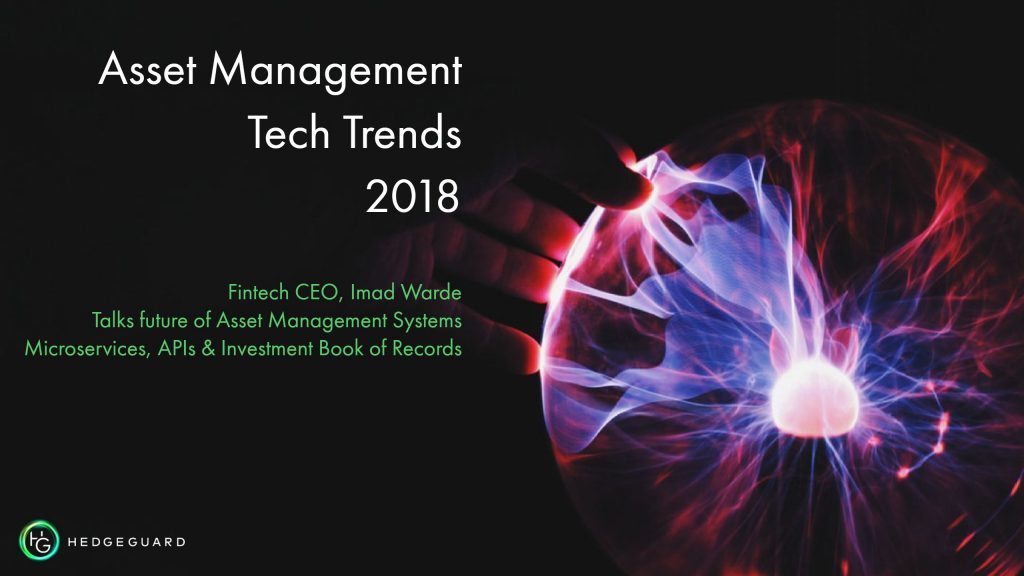Imad Warde, HedgeGuard’s CO-CEO & Founder shares his outlook on asset management technology, the infrastructure surrounding an asset manager’s Investment Book of Record and their Portfolio Management System:
How has the technology assisting asset managers evolved in recent years, and what has been the main driver of that change?
In the last ten years internet connection speed has increased by 50x, computer processing is operating at a speed of 100x and with the assistance of SSDs, disk storage and performance has significantly expanded. To sum up, we have access to much more speed which is a derivative of technology evolution. The growth of the asset management industry is directly linked to speed and holds the potential to thrive through the digital age from this factor.
There has also been a rise in companies providing hardware outsourcing and external locations for cloud-based host servers. These are compliant with Business Continuity/Disaster Recovery Plans all facilitated by fast internet connections.
Apps have started talking to each other by the design of APIs, in non-tech talk this means various software platforms are able to communicate through clever integrations. Fund managers can connect to intelligence and interpret greater levels of information due to software communication. This calibre of technology has become more accessible due to the lowering costs whilst we observe its’ continued evolution. That’s why we have seen the growth of ETFs and Systematic funds centred around automation. They have taken advantage of the cost-effective opportunities presented to the fund industry.
What are the key factors asset managers should consider when looking at acquiring new technology?
Firstly, look to ensure the flexibility and openness of the technology. The technology hasn’t been developed by asset managers, therefore their immediate requirement will be to import and export their specific data with the absence of a manual element.
Address the structure of the technology and the key questions to ask are;
- How easy is it to use all data?
- Can I browse the database and utilise all of its features?
The answer you’re looking for is; user friendly tech is possible by the use of APIs.
Secondly, assess the team behind the technology. An asset manager mustn’t need excessive time to learn the new technology, however gaining access to tech without the knowledge is useless. Make it a priority to talk to the different levels of technical experts within the tech company and support team. You are not only acquiring a new tech solution but also recruiting a new tech team, providers of tech should be considered a part of your team and it is advisable to carry out due diligence.
Take a read of our guide when choosing your new portfolio management system.
What are the current pain points you’ve observed from your clients?
Many fund managers start off by building their own tech but reach a glass ceiling when it’s time to scale up their AUM as their infrastructure doesn’t scale alongside performance. Managers have tech employees but not tech teams and experience single points of failure during employee turnover.
No portfolio management system is completely comprehensive, there are some software solutions that are good for risk management but have poor shadow reconciliation and others that have good execution systems but poor cash management.
HedgeGuard have identified this industry-wide pain point and as a result built microservices to equip fund managers with the specific tools they require. Microapps can run along other software or connect to other microapps.
Asset managers are re-evaluating their operational structures to realign their profit generating activities and concentrating resources on what they excel at, that is portfolio management.
What role does the middle office play in asset management today?
The Middle office function is responsible for the accuracy of data; this is lacking today. In order to be compliant with regulations, the front office should ensure the use of an accurate set of pre-trade data, ensured by their middle office.
Middle office is instrumental to the success of an asset manager. In order for a manager to view true positions of their portfolio, their middle office must be supported by a technology infrastructure facilitating accurate trade, stock and cash reconciliation as well as settlement on a T+1 basis.
What are the benefits of outsourcing middle office functions?
The benefit is simple, fund managers can focus on portfolio management activities and their employees can allocate resources on front office alpha generating tasks.
How are potential changes in the regulatory landscape affecting Hedge fund’s technology offering?
The industry can benefit from the increase of focused tech providers who solve specific problems and give access to specialised data facilitated by the increase in API coding. We are seeing a rise in specialisation and open business applications that tackle specific requirements. Techs are making the most of their comparative advantage to deliver high quality software solutions which can be easily integrated with peer microservices to create each asset manager’s unique tech platform/network.
From a business perspective, asset managers should be optimistic about where the industry is moving.
What are the impactful trends in asset management technology that you forecast in 2018?
We are going to see a surge of cryptocurrency funds launching in 2018 and new cryptocurrency technology entering the asset management arena. Some market makers and managers have already gained exposure to the digital asset class to provide liquidity, whilst others are arbitrage trading.
In the next 5-10 years, an asset manager’s digital quotient described by McKinsey as a company’s ‘digital maturity’ will be a key factor to performance against peers.
Begin your asset management innovative journey by exploring how your Investment Book of Record should be upgraded, followed by our Portfolio Management System here.

